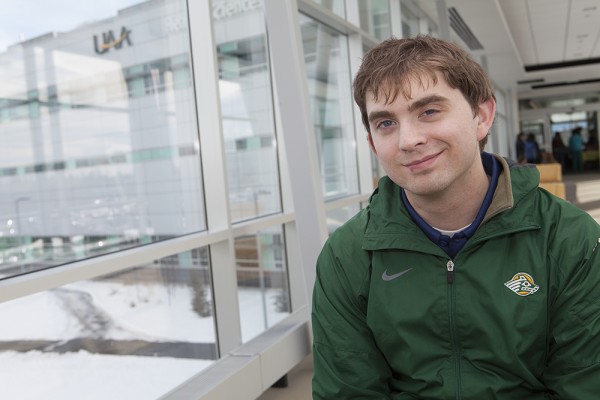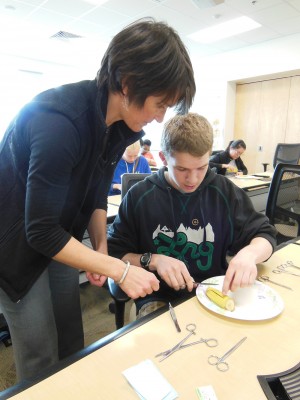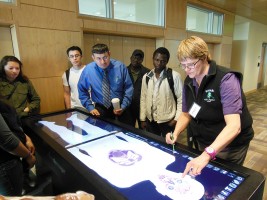UAA PreMed Summit helps students plot smart course
by Tracy Kalytiak |
UAA student Iain Miller balances an incredible schedule.

Iain Miller, a UAA student, hopes someday to enroll in the Alaska WWAMI program and train to become an emergency room physician. He'll be attending the upcoming Alaska PreMed Summit, April 2 at Rasmuson Hall. (Photo by Philip Hall / University of Alaska Anchorage)
He has three degrees in play-Iain is working on bachelor's degrees in biological sciences and Spanish as well as an associate degree in fire and emergency services. And he works 60 hours a week. And he is tending two funded research projects.
"My life is very, very scheduled," he said. "Even during spring break I was doing 10- to 12-hour days at the library. I wouldn't say I don't have a social life, but my calendar is very important to how I run my life."
Health care is a key element in Iain's plans for his future. He has served as an officer in UAA's PreMed Club, worked as a job shadow both here and in Bethel, and wants someday to attend Alaska WWAMI-a University of Washington School of Medicine program. His goal? To become an emergency room physician.
"I really feel passion for emergency medicine," he said. "You don't necessarily know what's going to come in the door. That pressure is something I thrive on."
Setting a prudent course
Iain is helping with preparations for Alaska WWAMI's upcoming 11th-annual Alaska PreMed Summit, scheduled for 9 a.m.-5 p.m., Saturday, April 2, at UAA's Rasmuson Hall and Health Sciences Building.

Dr. Tanya Leinecke helps a student suture a banana during last year's Alaska PreMed Summit, at UAA. (Photo courtesy of Alaska WWAMI)
Why is the Summit relevant?
"One of the things I always really look forward to is, admissions folks from the University of Washington come up and do some presentations," Iain said. "If folks are even considering applying to WWAMI, it can be a good opportunity to get that specific information you otherwise wouldn't be able to get. It typically seems to get tweaked based on the latest class that's been accepted, provides the most up-to-date information. You're really getting it right from the horse's mouth."
In addition to UW Director of Admissions Stella Yee's presentation about the University of Washington's admissions process for medical school, the Summit agenda includes UAA's Ian van Tets and Quentin Reuer conducting breakout sessions focused on what pre-college students, undergraduates and nontraditional students can do to better prepare themselves for medical school.
"I talk about steps involved in that pathway [to medical school], courses in high school, types of degrees you should consider, the prerequisites you need and what to do when you hit the ground in college," van Tets said.
Van Tets said he emphasizes the advantage of taking math through to the end of a high schooler's senior year, starting chemistry and biology early, advantages and disadvantages of high school [advanced placement] courses and, most important, correcting myths.
"Such as, becoming a doctor requires 12 years of schooling," he said. "Correcting that so they know what's actually involved in each stage. After a baccalaureate degree, it's more of an apprenticeship program. A lot of students don't see that."
Other presentations will highlight best practices for interviewing, and information and networking opportunities.

Jamie Elswick conducts an anatomy table workshop at last year's Alaska PreMed Summit. (Photo courtesy of Alaska WWAMI)
"WWAMI students have contributed in various ways to all of the Premed Summits," Reuer said. "We offer mock interviews to people who register for the Summit, and past sessions have dealt with topics such as MCAT-Medical College Admission Test-preparation, tips for successful interviewing and how to acquire the necessary physician shadowing and volunteer experiences."
Gloria Burnett, director of the Alaska Center for Rural Health, and WWAMI students will talk about volunteer and job shadow experience, and keynote speaker Dr. Tom Nighswander will discuss medicine in Alaska in the past, present and future.
Joined by WWAMI students, Ryan Shercliffe will present a simulation center activity; Jamie Elswick will demonstrate a virtual anatomy table and Dr. Tanya Leinicke will show Summit participants how to suture a banana.
"The aim of the Summit is to help people do the right things before they hit college, so they can be prepared to do the right things at college and be the best candidate they can be in the application process," van Tets said.
Finding fulfillment
Iain plans to take a more leisurely route to medical school. After earning his associate degree and array of bachelor's degrees, he plans this fall to launch into studies for a master's degree in epidemiology.
"I didn't apply to any medical schools this cycle," he said. "I'll be doing that toward the end of my master's program."
Epidemiology, he said, is a field of medicine that "definitely differs a bit from my interest in emergency medicine but is pertinent to emergency medicine and primary care since that's the area epidemics and widespread disease are initially going to be observed."
Iain joked about the enormous hoard of credits he's amassed during his years at UAA.
"I've definitely had some challenges as far as trying to complete the plethora of academics I've started for myself," he laughed. "I already have almost 300 credits!"
Written by Tracy Kalytiak, UAA Office of University Advancement
 "UAA PreMed Summit helps students plot smart course" is licensed under a Creative Commons Attribution-NonCommercial 4.0 International License.
"UAA PreMed Summit helps students plot smart course" is licensed under a Creative Commons Attribution-NonCommercial 4.0 International License.














